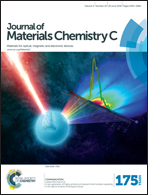Manipulation of electrical characteristics of non-volatile transistor-type memory devices through the acceptor strength of donor–acceptor conjugated copolymers†
Abstract
We report a nonvolatile organic transistor-type memory based on biaxially extended quaterthiophene (4T) and dithienothiophene-based donor (D)–acceptor (A) copolymers. In this work, the effects of donor–acceptor chemical structures on the memory characteristics were investigated. We have found that the charge storage capability can be manipulated by the acceptor strength of the donor–acceptor copolymers. 4T-based D–A copolymers with strong electron-accepting benzothiadiazole (P4T-BT) and diketopyrrolopyrrole (P4T-DPP) exhibited large memory windows (55 and 79 V, respectively). However, the donor-only copolymer, poly(4T-dithenothiophene) (P4T-DTT), and the D–A copolymer with weak electron-withdrawing qunioxaline (P4T-Q) showed smaller memory windows of 7 and 11 V, respectively. This indicates that the strong acceptors play a crucial rule in enhancing memory behaviors. The ON and OFF states of the D–A polymer devices can be maintained over 3 × 104 s with the Ion/Ioff current ratios of 102–105, and the write–read–erase–read (WRER) cycles can be operated over 200 cycles, indicating excellent nonvolatile flash-type memory behaviors. To the best of our knowledge, this study is the first work systematically investigating the influence of the chemical structures of the acceptor moieties on the nonvolatile flash polymer memory applications.



 Please wait while we load your content...
Please wait while we load your content...